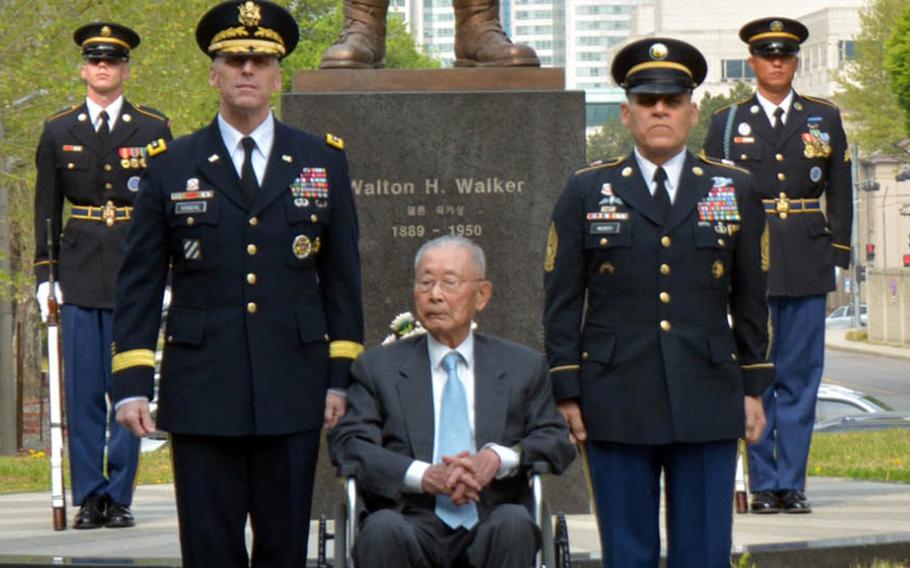
Lt. Gen. Thomas Vandal, from left, 8th Army commander, retired South Korean Gen. Paik Sun-yup and Command Sgt. Maj. Richard Merritt pose in front of the bronze statue of Korean War hero Lt. Gen. Walton Walker at Yongsan Garrison in Seoul, South Korea, Tuesday, April 25, 2017. (Kim Gamel/Stars and Stripes)
SEOUL, South Korea — After years of delays, the 8th Army headquarters started the clock Tuesday on completing its move to a base south of the South Korean capital by mid-July.
The timeline was announced Tuesday at a ceremony announcing plans to move the bronze statue of Lt. Gen. Walton Walker, a Korean War hero.
The statue, which stands in front of the 8th Army’s headquarters at Yongsan Garrison in Seoul, shows Walker pointing toward North Korea.
Current 8th Army commander Lt. Gen. Thomas Vandal addressed concerns that the planned relocation of the bulk of U.S. forces in Korea to an expanded Camp Humphreys near the city of Pyeongtaek may affect readiness against the growing nuclear and missile threat from Pyongyang.
“Despite the statue moving, make no mistake about it: our alliance and the katchi kapsida [we go together] spirit remains ironclad and strong,” he said during the ceremony.
“I can assure you at the unveiling of the statue this summer that General Walker will once again point towards the North as an everlasting reminder of the threat that we face,” he added.
The statue won’t actually be moved until next week. It will be unveiled at the official July 13 ceremony of the 8th Army’s new headquarters at Camp Humphreys, Vandal said.
He also suggested the overall shift south won’t be completed until 2021.
The $10.7 billion expansion of Camp Humphreys — which will eventually replace Yongsan as the main U.S. military base in South Korea — has been frequently postponed since Washington and Seoul agreed in 2004 to move U.S. forces south.
It was then set to take place in 2008, but was pushed back to 2012, then 2016 and 2017 due in large part to construction problems and quality control issues, as South Korea funded and provided much of the labor for the massive project.
Several units, including some rotational brigades from the front lines near North Korea, have already redeployed. The 8th Army headquarters also has sent an advance team.
Not all U.S. military forces are moving. The commander of U.S. Forces Korea is expected to maintain a presence at Yongsan, and the 210th Field Artillery Brigade will remain near the border until South Korea develops similar capabilities.
USFK divides the country into four areas designated according to their proximity to the heavily fortified border, with Area 1 being the closest.
“We’re all excited to be part of this historic relocation,” Vandal said. “The Area 3 population will increase in size to 45,000 soldiers and family members by 2021.” The statue of Walker, who is credited with helping to buy time so U.S.-led forces could turn the tide of the 1950-53 war against North Korea, was erected in 2010 by the U.S.-South Korean Alliance Friendship Association.
It cost about $575,000, including the statue and its foundation, according to the group’s general secretary, Kim Jin Seob.
The South Korean government is responsible for funding the relocation of all statues on Yongsan as part of its agreement to pay for the bulk of the relocation cost, officials said.
Also present at Tuesday’s ceremony was retired Korean Army Gen. Paik Sun-yup, who worked with Walker. The 8th Army has designated the nonagenarian an honorary commanding general for his role in the war.
The United States maintains about 28,500 servicemembers in South Korea, which remains technically at war with the North after the Korean War ended in an armistice instead of a peace treaty.
Stars and Stripes reporter Yoo Kyong Chang contributed to this report.
gamel.kim@stripes.com Twitter: @kimgamel